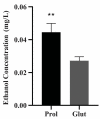Proteomics of Paracoccidioides lutzii: Overview of Changes Triggered by Nitrogen Catabolite Repression
- PMID: 37998907
- PMCID: PMC10672198
- DOI: 10.3390/jof9111102
Proteomics of Paracoccidioides lutzii: Overview of Changes Triggered by Nitrogen Catabolite Repression
Abstract
Members of the Paracoccidioides complex are the causative agents of Paracoccidioidomycosis (PCM), a human systemic mycosis endemic in Latin America. Upon initial contact with the host, the pathogen needs to uptake micronutrients. Nitrogen is an essential source for biosynthetic pathways. Adaptation to nutritional stress is a key feature of fungi in host tissues. Fungi utilize nitrogen sources through Nitrogen Catabolite Repression (NCR). NCR ensures the scavenging, uptake and catabolism of alternative nitrogen sources, when preferential ones, such as glutamine or ammonium, are unavailable. The NanoUPLC-MSE proteomic approach was used to investigate the NCR response of Paracoccidioides lutzii after growth on proline or glutamine as a nitrogen source. A total of 338 differentially expressed proteins were identified. P. lutzii demonstrated that gluconeogenesis, β-oxidation, glyoxylate cycle, adhesin-like proteins, stress response and cell wall remodeling were triggered in NCR-proline conditions. In addition, within macrophages, yeast cells trained under NCR-proline conditions showed an increased ability to survive. In general, this study allows a comprehensive understanding of the NCR response employed by the fungus to overcome nutritional starvation, which in the human host is represented by nutritional immunity. In turn, the pathogen requires rapid adaptation to the changing microenvironment induced by macrophages to achieve successful infection.
Keywords: NCR-proline; Paracoccidioides; metabolic reprogramming; nitrogen starvation; proteomics.
Conflict of interest statement
The authors declare no conflict of interest.
Figures








Similar articles
-
Nitrogen Catabolite Repression in members of Paracoccidioides complex.Microb Pathog. 2020 Dec;149:104281. doi: 10.1016/j.micpath.2020.104281. Epub 2020 Jun 23. Microb Pathog. 2020. PMID: 32585293
-
Paracoccidioides lutzii Formamidase Contributes to Fungal Survival in Macrophages.Microorganisms. 2022 Oct 12;10(10):2011. doi: 10.3390/microorganisms10102011. Microorganisms. 2022. PMID: 36296287 Free PMC article.
-
Transcriptional and proteomic responses to carbon starvation in Paracoccidioides.PLoS Negl Trop Dis. 2014 May 8;8(5):e2855. doi: 10.1371/journal.pntd.0002855. eCollection 2014 May. PLoS Negl Trop Dis. 2014. PMID: 24811072 Free PMC article.
-
Paracoccidioides-host Interaction: An Overview on Recent Advances in the Paracoccidioidomycosis.Front Microbiol. 2015 Nov 25;6:1319. doi: 10.3389/fmicb.2015.01319. eCollection 2015. Front Microbiol. 2015. PMID: 26635779 Free PMC article. Review.
-
Transcriptomic reprogramming of genus Paracoccidioides in dimorphism and host niches.Fungal Genet Biol. 2015 Aug;81:98-109. doi: 10.1016/j.fgb.2014.01.008. Epub 2014 Feb 18. Fungal Genet Biol. 2015. PMID: 24560614 Review.
Cited by
-
Mitochondrial inhibitors: a new horizon in breast cancer therapy.Front Pharmacol. 2024 Jul 4;15:1421905. doi: 10.3389/fphar.2024.1421905. eCollection 2024. Front Pharmacol. 2024. PMID: 39027328 Free PMC article. Review.
-
Paracoccidioides lutzii Infects Galleria mellonella Employing Formamidase as a Virulence Factor.PLoS Negl Trop Dis. 2024 Sep 3;18(9):e0012452. doi: 10.1371/journal.pntd.0012452. eCollection 2024 Sep. PLoS Negl Trop Dis. 2024. PMID: 39226308 Free PMC article.
References
-
- Shikanai-Yasuda M.A., Mendes R.P., Colombo A.L., Queiroz-Telles F.d., Kono A.S.G., Paniago A.M., Nathan A., Valle A.C.F.d., Bagagli E., Benard G. Brazilian guidelines for the clinical management of paracoccidioidomycosis. Rev. Soc. Bras. Med. Trop. 2017;50:715–740. doi: 10.1590/0037-8682-0230-2017. - DOI - PubMed
Grants and funding
- 478990/2012-0 and 408042/2021-4/National Council for Scientific and Technological Development
- INCT-IPH-FAPEG/Fundação de Apoio a Pesquisa do Estado de Goiás
- 308237/2022-6/National Council for Scientific and Technological Development
- DS fellowships/Coordenação de Aperfeicoamento de Pessoal de Nível Superior
LinkOut - more resources
Full Text Sources

